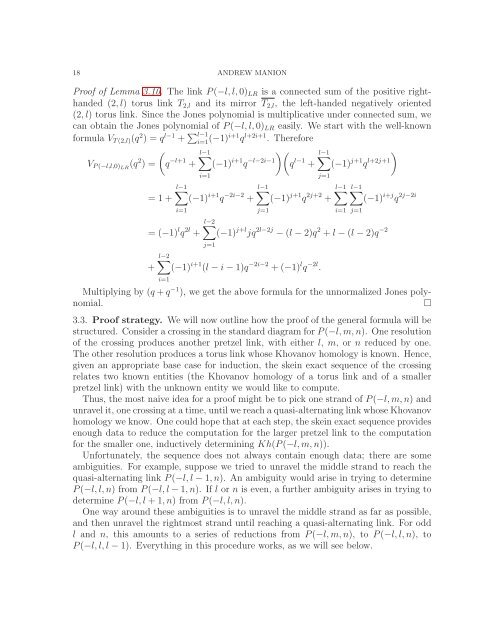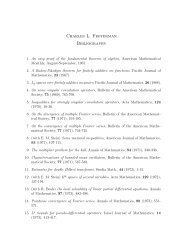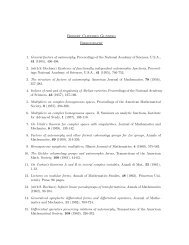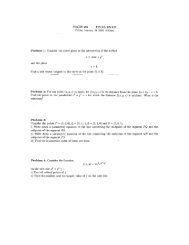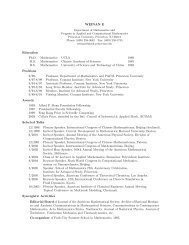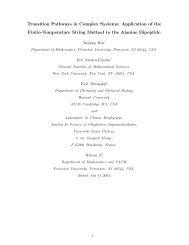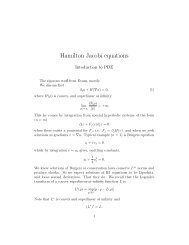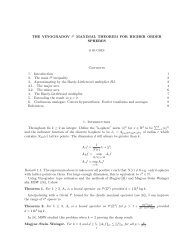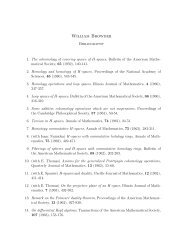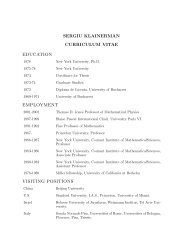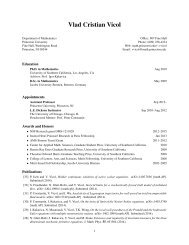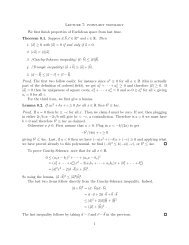The rational Khovanov homology of 3-strand pretzel links
The rational Khovanov homology of 3-strand pretzel links
The rational Khovanov homology of 3-strand pretzel links
You also want an ePaper? Increase the reach of your titles
YUMPU automatically turns print PDFs into web optimized ePapers that Google loves.
18 ANDREW MANION<br />
Pro<strong>of</strong> <strong>of</strong> Lemma 3.10. <strong>The</strong> link P(−l,l, 0) LR is a connected sum <strong>of</strong> the positive righthanded<br />
(2,l) torus link T 2,l and its mirror T 2,l , the left-handed negatively oriented<br />
(2,l) torus link. Since the Jones polynomial is multiplicative under connected sum, we<br />
can obtain the Jones polynomial <strong>of</strong> P(−l,l, 0) LR easily. We start with the well-known<br />
formula V T(2,l) (q 2 ) = q l−1 + ∑ l−1<br />
i=1 (−1)i+1 q l+2i+1 . <strong>The</strong>refore<br />
(<br />
∑l−1<br />
∑l−1<br />
)<br />
V P(−l,l,0)LR (q 2 ) = q −l+1 + (−1) i+1 q<br />
)(q −l−2i−1 l−1 + (−1) j+1 q l+2j+1<br />
i=1<br />
∑l−1<br />
∑l−1<br />
∑l−1<br />
∑l−1<br />
= 1 + (−1) i+1 q −2i−2 + (−1) j+1 q 2j+2 + (−1) i+j q 2j−2i<br />
i=1<br />
j=1<br />
∑l−2<br />
= (−1) l q 2l + (−1) j+l jq 2l−2j − (l − 2)q 2 + l − (l − 2)q −2<br />
j=1<br />
∑l−2<br />
+ (−1) i+1 (l − i − 1)q −2i−2 + (−1) l q −2l .<br />
i=1<br />
Multiplying by (q + q −1 ), we get the above formula for the unnormalized Jones polynomial.<br />
□<br />
3.3. Pro<strong>of</strong> strategy. We will now outline how the pro<strong>of</strong> <strong>of</strong> the general formula will be<br />
structured. Consider a crossing in the standard diagram for P(−l,m,n). One resolution<br />
<strong>of</strong> the crossing produces another <strong>pretzel</strong> link, with either l, m, or n reduced by one.<br />
<strong>The</strong> other resolution produces a torus link whose <strong>Khovanov</strong> <strong>homology</strong> is known. Hence,<br />
given an appropriate base case for induction, the skein exact sequence <strong>of</strong> the crossing<br />
relates two known entities (the <strong>Khovanov</strong> <strong>homology</strong> <strong>of</strong> a torus link and <strong>of</strong> a smaller<br />
<strong>pretzel</strong> link) with the unknown entity we would like to compute.<br />
Thus, the most naive idea for a pro<strong>of</strong> might be to pick one <strong>strand</strong> <strong>of</strong> P(−l,m,n) and<br />
unravel it, one crossing at a time, until we reach a quasi-alternating link whose <strong>Khovanov</strong><br />
<strong>homology</strong> we know. One could hope that at each step, the skein exact sequence provides<br />
enough data to reduce the computation for the larger <strong>pretzel</strong> link to the computation<br />
for the smaller one, inductively determining Kh(P(−l,m,n)).<br />
Unfortunately, the sequence does not always contain enough data; there are some<br />
ambiguities. For example, suppose we tried to unravel the middle <strong>strand</strong> to reach the<br />
quasi-alternating link P(−l,l − 1,n). An ambiguity would arise in trying to determine<br />
P(−l,l,n) from P(−l,l − 1,n). If l or n is even, a further ambiguity arises in trying to<br />
determine P(−l,l + 1,n) from P(−l,l,n).<br />
One way around these ambiguities is to unravel the middle <strong>strand</strong> as far as possible,<br />
and then unravel the rightmost <strong>strand</strong> until reaching a quasi-alternating link. For odd<br />
l and n, this amounts to a series <strong>of</strong> reductions from P(−l,m,n), to P(−l,l,n), to<br />
P(−l,l,l − 1). Everything in this procedure works, as we will see below.<br />
j=1<br />
i=1<br />
j=1


